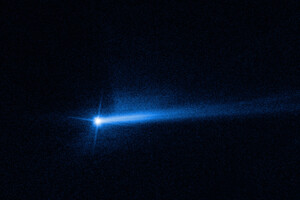Asteroid Dimorph has two tails.

Scientists studied pictures of the Didim-Dimorph system taken by the Hubble telescope, and noticed something unusual about them. After the collision with the DART vehicle, which crashed into the Dimorph, it had two tails of debris, the European Space Agency reports.
Available data indicate that the mission was successful. As a result of the collision, the orbit of Dimorph, which revolves around Didim in 11 hours and 55 minutes, was shortened by 32 minutes. what the debris cloud formed from the collision turned into.
Also read: Astronomers noticed something unusual in the behavior of the “potentially dangerous” asteroid Phaeton
Observations show that the ejected material or “ejection” expanded and lost brightness over time, as expected. But the formation of the second tail was a surprise. Hubble images show that the second tail appeared between October 2 and 8.
Relationship between the comet-like tail and other ejecta features seen at different times in Hubble images and other telescopes, is still unclear. A group of scientists is currently working on its search. Researchers are studying several possible scenarios for the appearance of such a tail.
Recall that the launch of the DART mission took place on November 24, 2021, it was carried out with the help of a Falcon 9 launch vehicle. On the night of September 27, it crashed into Dimorph at a speed of about 23 760 kilometers per hour.
Related video
The dual system was opened back in 1996. It consists of two celestial bodies: Didyma with a diameter of about 780 meters and Dimorph, whose diameter is estimated at 160 meters.




